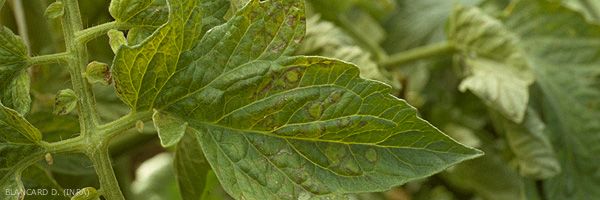
Tomato spotted wilt virus
(LORD)
Tomato leaf spot virus
- classification : Tospovirus, Bunyaviridae
The wilt virus disease of tomato ( Tomato spotted wilt virus , TSWV) is extremely polyphagous . In almost global distribution , it occurs more or less seriously in many tomato farmers countries on several continents. It is mainly present in temperate and subtropical regions of the world. Like the Californian thrips, TSWV has experienced an upsurge on almost every continent since the 1980s.
Its damage can be very important in several states of the United States, in various countries of Eastern Europe (Bulgaria, Hungary, Poland ) and in Greece. It seems to be on the rise in a few countries in Asia and Oceania.
In France , this virus , which affected several cultures before the Second World War, had more or less completely disappeared. During the 1980s, the introduction of a new vector, the thrips Frankliniella occidentalis , greatly compromised this situation. It is now considered of concern for many horticultural productions. In some regions, the coexistence of other vegetable or flower crops contaminated with tomatoes gives rise to serious epidemics causing sometimes significant damage. Crops grown in the open or under cover can be affected, more often in summer.
The age of the plants at the time of infection has a great influence on yield losses: the earlier the attacks, the higher their incidence will be. Late attacks do not appear to be without consequences for the crop, however, greatly reducing the production of marketable fruits due to abnormal ripening.
TSWV was first observed on Lycopersicon esculentum in 1915 in Australia. It is the type species of the genus Tospovirus (Figure 1). For many years, two different viruses have been grouped together under the name "TSWV", initially separated into two serologically groups distinct :
- the L-TSWV group (for “lettuce”) which appeared to be the most widespread;
- the I-TSWV group (for “ Impatiens ”); isolates from this group are now considered to belong to another viral species (described in 1990), which received the designation " Impatiens necrotic spot virus " .
 |
| Figure 1 |
In addition, several variants have been reported in the literature, differing in the severity of their symptoms, the efficiency of their transmission by their vectors (several species of thrips) and their ability to bypass certain resistance genes. Note that variants were obtained by treatment with nitrous acid; their highly attenuated pathogenicity has made it possible to protect plants against aggressive strains.
The purified viral particles of TSWV are almost spherical, rough, their diameter varies from 70 to 120 nm. The particles are surrounded by a unitary membrane with, on the outer surface, protrusions and glycoprotein projections 5 nm thick. The morphological properties of Tospoviruses are unique among viruses affecting Solanaceae, and even among all known phytoviruses.





